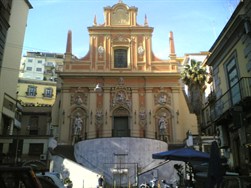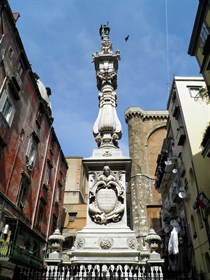The churches of Naples and some symbols of the city
 Among the religious buildings, there are many Neapolitan Baroque churches built by Fanzago or that he renovated and modernized. For example, the Church of San Giorgio Maggiore (Saint George Major) was partially rebuilt by the architect from Clusone following a fire in 1640 which damaged the structure. Similarly, the Basilica of Santa Maria Egiziaca (Saint Mary of Egypt) at Pizzafalcone and the churches of San Giuseppe (Saint Joseph) at Pontecorvo and Santa Maria degli Angeli alle Croci (Saint Mary of the Angels at the Croci) underwent renovation and modernization, entirely or only for certain periods of time, by Cosimo Fanzago. The church of Santa Teresa a Chiaia (Saint Theresa at Chiaia, photo) was built entirely based on a project of Fanzago’s, and remains one of the finest examples of Neapolitan Baroque despite the earthquake in 1688 which caused extensive damage. In many other churches, the artist has left his mark through the construction of chapels, altars and various sculptural works: an example of this is the aforementioned church of Santa Maria of Constantinople, the bust of Girolamo Flerio can be seen above the main altar.
Among the religious buildings, there are many Neapolitan Baroque churches built by Fanzago or that he renovated and modernized. For example, the Church of San Giorgio Maggiore (Saint George Major) was partially rebuilt by the architect from Clusone following a fire in 1640 which damaged the structure. Similarly, the Basilica of Santa Maria Egiziaca (Saint Mary of Egypt) at Pizzafalcone and the churches of San Giuseppe (Saint Joseph) at Pontecorvo and Santa Maria degli Angeli alle Croci (Saint Mary of the Angels at the Croci) underwent renovation and modernization, entirely or only for certain periods of time, by Cosimo Fanzago. The church of Santa Teresa a Chiaia (Saint Theresa at Chiaia, photo) was built entirely based on a project of Fanzago’s, and remains one of the finest examples of Neapolitan Baroque despite the earthquake in 1688 which caused extensive damage. In many other churches, the artist has left his mark through the construction of chapels, altars and various sculptural works: an example of this is the aforementioned church of Santa Maria of Constantinople, the bust of Girolamo Flerio can be seen above the main altar.
 In addition to the construction of palaces and religious buildings, Fanzago changed the face of Naples through other works which are symbols of the city. The Spire of San Gennaro was built in 1636 as thanksgiving for the saint’s protection of the population during the eruption of Vesuvius in 1631After a period of inactivity that lasted over 100 years, Vesuvius began to erupt at the dawn of 16 December 1631. There were warning signals in the days before it, such as seismic movements and swelling of the soil, but the eruption was terribly destructive. After 17 days of volcanic activity, there were over 4,000 dead and more than 40,000 displaced people. Towns such as Portici, Torre Annunziata, Torre del Greco and Somma Vesuviana were partially destroyed.. However, due to numerous setbacks, the work was not completed until 1660. The Sebeto fountain was designed by Cosimo Fanzago but then actually built by his son CarloSon and pupil of Cosimo Fanzago, Carlo (1618-1678) was never able to emerge from the shadow of his father. He assisted him in the creation of some works, such as the fountain of Sebeto, and work in various sites, such as the Charterhouse of San Martino. The most famous work of Carlo Fanzago is the Dead Christ in the altarpiece of the main altar of the church of Santa Maria degli Angeli alle Croci (1639-1644). He also worked in Spain, where his life probably ended.. Originally located in via Gusmana (now Via Cesario Console), the fountain was moved, in 1939, to its current location in largo Sermoneta.
In addition to the construction of palaces and religious buildings, Fanzago changed the face of Naples through other works which are symbols of the city. The Spire of San Gennaro was built in 1636 as thanksgiving for the saint’s protection of the population during the eruption of Vesuvius in 1631After a period of inactivity that lasted over 100 years, Vesuvius began to erupt at the dawn of 16 December 1631. There were warning signals in the days before it, such as seismic movements and swelling of the soil, but the eruption was terribly destructive. After 17 days of volcanic activity, there were over 4,000 dead and more than 40,000 displaced people. Towns such as Portici, Torre Annunziata, Torre del Greco and Somma Vesuviana were partially destroyed.. However, due to numerous setbacks, the work was not completed until 1660. The Sebeto fountain was designed by Cosimo Fanzago but then actually built by his son CarloSon and pupil of Cosimo Fanzago, Carlo (1618-1678) was never able to emerge from the shadow of his father. He assisted him in the creation of some works, such as the fountain of Sebeto, and work in various sites, such as the Charterhouse of San Martino. The most famous work of Carlo Fanzago is the Dead Christ in the altarpiece of the main altar of the church of Santa Maria degli Angeli alle Croci (1639-1644). He also worked in Spain, where his life probably ended.. Originally located in via Gusmana (now Via Cesario Console), the fountain was moved, in 1939, to its current location in largo Sermoneta.
